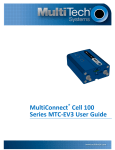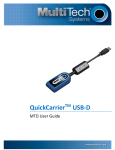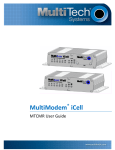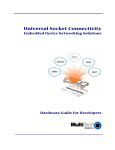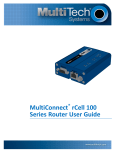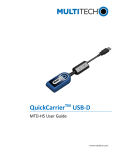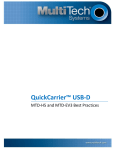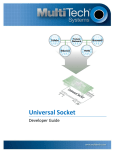Download Multitech E Specifications
Transcript
QuickCarrier™ USB-E MT100UCC-C2 Developer Guide QUICKCARRIER™ USB-E MT100UCC-C2 DEVELOPER GUIDE QuickCarrier™ USB-E MT100UCC-C2 Developer Guide Models: MT100UCC-C2 Part Number: S000575 Version: 1.0.1 Copyright This publication may not be reproduced, in whole or in part, without the specific and express prior written permission signed by an executive officer of Multi-Tech Systems, Inc. All rights reserved. Copyright © 2013 by Multi-Tech Systems, Inc. Multi-Tech Systems, Inc. makes no representations or warranties, whether express, implied or by estoppels, with respect to the content, information, material and recommendations herein and specifically disclaims any implied warranties of merchantability, fitness for any particular purpose and noninfringement. Multi-Tech Systems, Inc. reserves the right to revise this publication and to make changes from time to time in the content hereof without obligation of Multi-Tech Systems, Inc. to notify any person or organization of such revisions or changes. Legal Notices The Multi-Tech products are not designed, manufactured or intended for use, and should not be used, or sold or re-sold for use, in connection with applications requiring fail-safe performance or in applications where the failure of the products would reasonably be expected to result in personal injury or death, significant property damage, or serious physical or environmental damage. Examples of such use include life support machines or other life preserving medical devices or systems, air traffic control or aircraft navigation or communications systems, control equipment for nuclear facilities, or missile, nuclear, biological or chemical weapons or other military applications (“Restricted Applications”). Use of the products in such Restricted Applications is at the user’s sole risk and liability. MULTI-TECH DOES NOT WARRANT THAT THE TRANSMISSION OF DATA BY A PRODUCT OVER A CELLULAR COMMUNICATIONS NETWORK WILL BE UNINTERRUPTED, TIMELY, SECURE OR ERROR FREE, NOR DOES MULTI-TECH WARRANT ANY CONNECTION OR ACCESSIBILITY TO ANY CELLULAR COMMUNICATIONS NETWORK. MULTI-TECH WILL HAVE NO LIABILITY FOR ANY LOSSES, DAMAGES, OBLIGATIONS, PENALTIES, DEFICIENCIES, LIABILITIES, COSTS OR EXPENSES (INCLUDING WITHOUT LIMITATION REASONABLE ATTORNEYS FEES) RELATED TO TEMPORARY INABILITY TO ACCESS A CELLULAR COMMUNICATIONS NETWORK USING THE PRODUCTS. The Multi-Tech products and the final application of the Multi-Tech products should be thoroughly tested to ensure the functionality of the Multi-Tech products as used in the final application. The designer, manufacturer and reseller has the sole responsibility of ensuring that any end user product into which the Multi-Tech product is integrated operates as intended and meets its requirements or the requirements of its direct or indirect customers. MultiTech has no responsibility whatsoever for the integration, configuration, testing, validation, verification, installation, upgrade, support or maintenance of such end user product, or for any liabilities, damages, costs or expenses associated therewith, except to the extent agreed upon in a signed written document. To the extent Multi-Tech provides any comments or suggested changes related to the application of its products, such comments or suggested changes is performed only as a courtesy and without any representation or warranty whatsoever. Contacting Multi-Tech Knowledge Base The Knowledge Base provides immediate access to support information and resolutions for all Multi-Tech products. Visit http://www.multitech.com/kb.go. Support Portal To create an account and submit a support case directly to our technical support team, visit: https://support.multitech.com. Support Business Hours: M-F, 9am to 5pm CT Country By Email By Phone Europe, Middle East, Africa: [email protected] +(44) 118 959 7774 U.S., Canada, all others: [email protected] (800) 972-2439 or (763) 717-5863 Warranty To read the warranty statement for your product, visit www.multitech.com/warranty.go. For other warranty options, visit www.multitech.com/es.go. World Headquarters Multi-Tech Systems, Inc. 2205 Woodale Drive, Mounds View, MN 55112 Phone: (800) 328-9717 or (763) 785-3500 Fax (763) 785-9874 2 QuickCarrier™ USB-E MT100UCC-C2 Developer Guide CONTENTS Contents Product Overview .................................................................................................................................................... 5 About the QuickCarrier USB-E MT100UCC-C2 .............................................................................................................. 5 Documentation ........................................................................................................................................................... 5 Selecting the Correct Model and Accessories............................................................................................................... 5 Design Considerations ............................................................................................................................................. 6 USB Design ................................................................................................................................................................... 6 Noise Suppression Design ............................................................................................................................................. 6 Electromagnetic Interference ...................................................................................................................................... 6 Electrostatic Discharge Control..................................................................................................................................... 7 Cellular Information................................................................................................................................................. 8 Antenna System Cellular Devices.................................................................................................................................. 8 CDMA Antenna Information ......................................................................................................................................... 8 CDMA Antenna Requirements/Specifications ............................................................................................................ 8 Coax Cables Specifications ............................................................................................................................................ 8 SMA-to-UFL and RSMA-to-UFL Coaxial Cables ............................................................................................................. 8 Coaxial Cable Specifications ....................................................................................................................................... 9 Approved Antenna Cable Parts .................................................................................................................................. 9 Activating Accounts for Cellular Devices....................................................................................................................... 9 Cellular Approvals and Labeling Requirements ......................................................................................................... 10 Modem Label Example.............................................................................................................................................. 10 QuickCarrier USB-E Label .......................................................................................................................................... 10 OEM Integration .................................................................................................................................................... 12 FCC Grant Notes.......................................................................................................................................................... 12 Grant Limitations ....................................................................................................................................................... 12 KDB 447498 Section 8 ................................................................................................................................................ 12 FCC Definitions ........................................................................................................................................................... 12 Host Labeling............................................................................................................................................................... 13 Safety Warnings..................................................................................................................................................... 14 Radio Frequency (RF) Safety ....................................................................................................................................... 14 Interference with Pacemakers and Other Medical Devices ...................................................................................... 14 Potential interference ............................................................................................................................................... 14 Precautions for pacemaker wearers ........................................................................................................................ 14 Vehicle Safety.............................................................................................................................................................. 15 Device Maintenance ................................................................................................................................................... 15 Handling Precautions .................................................................................................................................................. 15 User Responsibility...................................................................................................................................................... 15 QuickCarrier™ USB-E MT100UCC-C2 Developer Guide 3 CONTENTS Regulatory Compliance Statements ....................................................................................................................... 16 47 CFR Part 15 Regulation Class B Devices ................................................................................................................. 16 Industry Canada Class B Notice................................................................................................................................... 17 Restriction of the Use of Hazardous Substances (RoHS) ............................................................................................ 18 MT100UCC-C2 Model Overview ............................................................................................................................. 19 Specifications .............................................................................................................................................................. 19 Mechanical drawing .................................................................................................................................................... 21 Power Draw MT100UCC-C2 ....................................................................................................................................... 22 Pinout Specifications................................................................................................................................................... 22 Application Notes .................................................................................................................................................. 23 MT100UCC-C2 Application Notes ............................................................................................................................... 23 LED Interface............................................................................................................................................................. 23 RF Interfaces ............................................................................................................................................................. 23 RF Performances ....................................................................................................................................................... 23 Configuring and Communicating with Your Device................................................................................................. 25 Interacting with Your Device Overview ...................................................................................................................... 25 Before You Begin......................................................................................................................................................... 25 Using Command Mode and Online Data Mode.......................................................................................................... 25 Verifying Signal Strength............................................................................................................................................. 26 Example .................................................................................................................................................................... 26 Checking Network Registration for EV2 Devices ........................................................................................................ 27 Sending and Receiving Data........................................................................................................................................ 27 Connecting Device to TCP Server as TCP Client ........................................................................................................ 27 Configuring Device as UDP Listener to Accept UDP Client Connections ................................................................. 28 Configuring Device as UDP Client to Connect to UDP Server ................................................................................... 29 Configuring Device as UDP Listener to Accept UDP Client Connections ................................................................. 30 Transferring FTP File to FTP Server ........................................................................................................................... 31 Downloading File from FTP Server............................................................................................................................ 32 Reading, Writing and Deleting Messages ................................................................................................................... 33 Reading Text Messages............................................................................................................................................. 33 Sending Text Messages ............................................................................................................................................. 33 Deleting Messages .................................................................................................................................................... 34 4 QuickCarrier™ USB-E MT100UCC-C2 Developer Guide PRODUCT OVERVIEW Product Overview About the QuickCarrier USB-E MT100UCC-C2 This guide describes how to use the QuickCarrier USB-E to embed M2M connectivity into your Windows or Linux device. The embedded cellular modem is a complete, ready-to-integrate communications device that offers 2G cellular connectivity options. The quick-to-market product combines a network approved cellular SocketModem® and a USB carrier card in one compact design. With its 4-pin USB interface the embedded cellular modem cables to an existing device’s internal USB port and can be secured using the four mounting holes located at the corners of the printed circuit board. Documentation The following table describes additional documentation for your device. The guides are available on the Multi-Tech support web site at www.multitech.com/man.go. Guide Description Part Number MT100UCC-C2 Developer Guide This guide. (S000575) AT Commands Reference Guide MT100UCC-C2 (S000546) Selecting the Correct Model and Accessories The following table describes which model and accessory kit to select for your needs. Model Description MT100UCC-C2-N2 Sprint 2G CDMA 1xRTT MT100UCC-C2-N3 Verizon 2G CDMA 1xRTT MT100UCC-C2-N16 Aeris 2G CDMA 1xRTT MT100UCC-AK Accessory kit, includes USB cables, antenna cable and antenna QuickCarrier™ USB-E MT100UCC-C2 Developer Guide 5 DESIGN CONSIDERATIONS Design Considerations USB Design Multi-Tech recommends that you review Intel's High Speed USB Platform Design Guidelines for information about USB signal routing, impedance, and layer stacking. Also: ■ Shield USB cables with twisted pairs (especially those containing D+/D-). ■ Use a single 5V power supply for USB devices. See the Power Draw section in your model’s Device Guide for current (ampere) requirements. ■ Route D+/D- together in parallel with the trace spacing needed to achieve 90 ohms differential impedance for the USB pair and to maintain a 20 mil space from the USB pair and all other signals. ■ If power is provided externally, use a common ground between the carrier board and the device. Noise Suppression Design Adhere to engineering noise-suppression practices when designing a printed circuit board (PCB) containing the MultiConnect PCIe. Noise suppression is essential to the proper operation and performance of the modem and surrounding equipment. Any OEM board design that contains the MultiConnect PCIe must consider both on-board and off-board generated noise that can affect digital signal processing. Both on-board and off-board generated noise that is coupled onboard can affect interface signal levels and quality. Noise in frequency ranges that affect modem performance is of particular concern. On-board generated electromagnetic interference (EMI) noise that can be radiated or conducted off-board is equally important. This type of noise can affect the operation of surrounding equipment. Most local government agencies have certification requirements that must be met for use in specific environments. Proper PC board layout (component placement, signal routing, trace thickness and geometry, and so on) component selection (composition, value, and tolerance), interface connections, and shielding are required for the board design to achieve desired modem performance and to attain EMI certification. Other aspects of proper noise-suppression engineering practices are beyond the scope of this guide. Consult noise suppression techniques described in technical publications and journals, electronics and electrical engineering text books, and component supplier application notes. Electromagnetic Interference The following guidelines are offered specifically to help minimize EMI generation. Some of these guidelines are the same as, or similar to, the general guidelines. To minimize the contribution of device-based design to EMI, you must understand the major sources of EMI and how to reduce them to acceptable levels. ■ Keep traces carrying high frequency signals as short as possible. ■ Provide a good ground plane or grid. In some cases, a multilayer board may be required with full layers for ground and power distribution. ■ Decouple power from ground with decoupling capacitors as close to the device's power pins as possible. ■ Eliminate ground loops, which are unexpected current return paths to the power source and ground. 6 QuickCarrier™ USB-E MT100UCC-C2 Developer Guide DESIGN CONSIDERATIONS ■ Decouple the telephone line cables at the telephone line jacks. Typically, use a combination of series inductors, common mode chokes, and shunt capacitors. Methods to decouple telephone lines are similar to decoupling power lines; however, telephone line decoupling may be more difficult and deserves additional attention. A commonly used design aid is to place footprints for these components and populate as necessary during performance/EMI testing and certification. ■ Decouple the power cord at the power cord interface with decoupling capacitors. Methods to decouple power lines are similar to decoupling telephone lines. ■ Locate high frequency circuits in a separate area to minimize capacitive coupling to other circuits. ■ Locate cables and connectors to avoid coupling from high frequency circuits. ■ Lay out the highest frequency signal traces next to the ground grid. ■ If using a multilayer board design, make no cuts in the ground or power planes and be sure the ground plane covers all traces. ■ Minimize the number of through-hole connections on traces carrying high frequency signals. ■ Avoid right angle turns on high frequency traces. Forty-five degree corners are good; however, radius turns are better. ■ On 2-layer boards with no ground grid, provide a shadow ground trace on the opposite side of the board to traces carrying high frequency signals. This will be effective as a high frequency ground return if it is three times the width of the signal traces. ■ Distribute high frequency signals continuously on a single trace rather than several traces radiating from one point. Electrostatic Discharge Control Handle all electronic devices with precautions to avoid damage due to the static charge accumulation. See the ANSI/ESD Association Standard (ANSI/ESD S20.20-1999) – a document “for the Development of an Electrostatic Discharge Control for Protection of Electrical and Electronic Parts, Assemblies and Equipment.” This document covers ESD Control Program Administrative Requirements, ESD Training, ESD Control Program Plan Technical Requirements (grounding/bonding systems, personnel grooming, protected areas, packaging, marking, equipment, and handling), and Sensitivity Testing. Multi-Tech strives to follow these recommendations. Input protection circuitry is incorporated in Multi-Tech devices to minimize the effect of static buildup. Take precautions to avoid exposure to electrostatic discharge during handling. Multi-Tech uses and recommends that others use anti-static boxes that create a faraday cage (packaging designed to exclude electromagnetic fields). Multi-Tech recommends that you use our packaging when returning a product and when you ship your products to your customers. QuickCarrier™ USB-E MT100UCC-C2 Developer Guide 7 CELLULAR INFORMATION Cellular Information Antenna System Cellular Devices The cellular/wireless performance depends on the implementation and antenna design. The integration of the antenna system into the product is a critical part of the design process; therefore, it is essential to consider it early so the performance is not compromised. If changes are made to the device's certified antenna system, then recertification will be required by specific network carriers. CDMA Antenna Information CDMA devices were approved with the following antenna: Exceltek Electronics, Ltd. Description: GSM quad band antenna Part number: C0081-ANG0002 Multi-Tech part number: 45009713L CDMA Antenna Requirements/Specifications Frequency range 824-894 MHz / 1850-1900 MHz Impedance 50 ohm VSWR Make sure VSWR does not exceed 2.0.1 at any point across the bands of operation Typical radiated gain radiation 2 dBi on azimuth plane Radiation Omni directional Polarization Vertical Coax Cables Specifications Category Description Cable type Coaxial cable Attenuation <1.0 db Connector impedance 50 ohm Maximum cable length 16 inches (40 cm) SMA-to-UFL and RSMA-to-UFL Coaxial Cables Note: RSMA cables are not supported for CDMA products. The Developer Kit includes the following cables: 8 QuickCarrier™ USB-E MT100UCC-C2 Developer Guide CELLULAR INFORMATION ■ One SMA-to-UFL cable for use with all cellular modems that have a UFL antenna connector. ■ One SMA-to-UFL cable for use with products that include an optional GPS receiver. Coaxial Cable Specifications Cable Type Coaxial Cable Attenuation <1.0db Connector Impedance 50 ohm Maximum Cable Length 16" (40 cm) Optional antenna cables can be ordered from Multi-Tech Systems, Inc. Part Number Description CASMA-UFL-1 SMA-to-UFL Coax Cable (Single Pack) CASMA-UFL-10 SMA-to-UFL Coax Cable (Ten Pack) CARSMA-UFL-1 RSMA-to-UFL Coax Cable (Single Pack) CARSMA-UFL-10 RSMA-to-UFL Coax Cable (Ten Pack) Approved Antenna Cable Parts GC Protronics: 20930C Samtec: ASP-116785-01 The coaxial cable is an RG-178/U Activating Accounts for Cellular Devices Some Multi-Tech cellular modems have been pre-configured to operate on a specific cellular network, such as Sprint and Verizon Wireless. However, before you can begin to use the modem, you must set up a cellular data account with your cellular network provider. Refer to Multi-Tech’s Cellular Activation Web site http://www.multitech.com/activation.go for information on activating your cellular modem. MEID, ESN, IMEI Information The cellular carrier asks you for device identification information, either MEID, ESN or IMEI depending on the type of product you are using:: ■ For CDMA: The modem's MEID is printed on the label. ■ For EV-DO or 1xRTT: The modem’s ESN is printed in hexadecimal format on the label. ■ For GPRS/HSPA+: The modem's 15-character IMEI (International Mobile Equipment Identity) number is printed on the modem's label. Refer to the device labels for the location of the device identification. QuickCarrier™ USB-E MT100UCC-C2 Developer Guide 9 CELLULAR INFORMATION IMPORTANT: Both the QuickCarrier USB-E and the modem include labels. When the cellular carrier asks you to provide the modem's model identification, give the Multi-Tech cellular model identification, not the host device model. Cellular Approvals and Labeling Requirements Approvals and Certification The Multi-Tech SocketModem is an Industry and/or Carrier Approved modem. In most cases, when integrated and used with an antenna system that was part of the Multi-Tech modem certification, no additional approvals or certifications are required (however, EV-DO has a few exceptions) for the device you develop as long as the following are met: ■ PTCRB Requirements (GPRS and HSPA+ only) The antenna system cannot be altered. ■ Model Identification The Multi-Tech model identification allows the carrier to verify the modem as one of its approved models This information is located on the modem's label. Modem Label Example Note: The label is shown larger than actual size. 1 Multi-Tech model information 2 MEID (C2) for the attached modem QuickCarrier USB-E Label Note: The label is shown larger than actual size. 10 QuickCarrier™ USB-E MT100UCC-C2 Developer Guide CELLULAR INFORMATION 1 Multi-Tech model information 2 Multi-Tech ordering part number 3 MEID (C2) for the attached modem QuickCarrier™ USB-E MT100UCC-C2 Developer Guide 11 OEM INTEGRATION OEM Integration FCC Grant Notes The OEM should follow all the grant notes listed below. Otherwise, further testing and device approvals may be necessary. The antenna gain, including cable loss, for the radio you are incorporating into your product design must not exceed the requirements at 850 MHz and 1900 MHz as specified by the FCC grant for mobile operations and fixed mounted operations as defined in 2.1091 and 1.1307 of the FCC rules for satisfying RF exposure compliance. Power output listed is conducted. This device is a mobile device with respect to RF exposure compliance. The antenna(s) used for this transmitter must be installed to provide a separation distance of at least 20 cm from all persons, and must not be collocated or operate in conjunction with any other antenna or transmitter except in accordance with FCC multi-transmitter product guidelines. Installers and end-users must be provided with specific information required to satisfy RF exposure compliance for installations and final host devices. (See note under Grant Limitations.) Compliance of this device in all final host configurations is the responsibility of the Grantee. Grant Limitations This device has been granted modular approval for mobile applications. Portable applications may require further RF exposure (SAR) evaluations. Examples of mobile devices include wireless routers, desktop computers, utility meters, etc. Examples of portable applications include devices such as a laptop, USB dongle, mobile phone, tablet PC, and any device that can be worn on the body during use. Your final product with this embedded device may need to pass FCC Part 15B. This device has not been evaluated or approved for simultaneous transmission. Any simultaneous transmission conditions should be evaluated per the current FCC KDB 447498 requirements. Simultaneous transmission requirements for mobile devices are contained in Section 8. KDB 447498 Section 8 Transmitters and modules certified for mobile or portable exposure conditions and categorically excluded by § 2.1091(c) can be incorporated in mobile host devices without further testing or certification when: The closest separation among all simultaneous transmitting antennas is ≥ 20 cm; or The antenna separation distance and MPE compliance boundary requirements that enable all simultaneous transmitting antennas incorporated within the host to comply with MPE limits are specified in the application filing of at least one of the certified transmitters incorporated in the host device. In addition, when transmitters certified for portable use are incorporated in a mobile host device the antenna(s) must be ≥ 5 cm from all other simultaneous transmitting antennas. All antennas in the final product must be at least 20 cm from users and nearby persons. If the host device requires further authorization, consult an accredited FCC laboratory for guidance. FCC Definitions Portable: (§2.1093) — A portable device is defined as a transmitting device designed to be used so that the radiating structure(s) of the device is/are within 20 centimeters of the body of the user. 12 QuickCarrier™ USB-E MT100UCC-C2 Developer Guide OEM INTEGRATION Mobile: (§2.1091) — A mobile device is defined as a transmitting device designed to be used in other than fixed locations and to generally be used in such a way that a separation distance of at least 20 centimeters is normally maintained between the transmitter’s radiating structure(s) and the body of the user or nearby persons. Host Labeling The following statements are required to be on the host label: ■ This device contains FCC ID: {Add the FCC ID of the specific device} ■ This device contains equipment certified under IC ID: {Add the IC ID of the specific device} For labeling examples, see Cellular Approvals and Labeling Requirements. QuickCarrier™ USB-E MT100UCC-C2 Developer Guide 13 SAFETY WARNINGS Safety Warnings Radio Frequency (RF) Safety Due to the possibility of radio frequency (RF) interference, it is important that you follow any special regulations regarding the use of radio equipment. Follow the safety advice given below. ■ Operating your device close to other electronic equipment may cause interference if the equipment is inadequately protected. Observe any warning signs and manufacturers’ recommendations. ■ Different industries and businesses restrict the use of cellular devices. Respect restrictions on the use of radio equipment in fuel depots, chemical plants, or where blasting operations are in process. Follow restrictions for any environment where you operate the device. ■ Do not place the antenna outdoors. ■ Switch OFF your wireless device when in an aircraft. Using portable electronic devices in an aircraft may endanger aircraft operation, disrupt the cellular network, and is illegal. Failing to observe this restriction may lead to suspension or denial of cellular services to the offender, legal action, or both. ■ Switch OFF your wireless device when around gasoline or diesel-fuel pumps and before filling your vehicle with fuel. ■ Switch OFF your wireless device in hospitals and any other place where medical equipment may be in use. Interference with Pacemakers and Other Medical Devices Potential interference Radiofrequency energy (RF) from cellular devices can interact with some electronic devices. This is electromagnetic interference (EMI). The FDA helped develop a detailed test method to measure EMI of implanted cardiac pacemakers and defibrillators from cellular devices. This test method is part of the Association for the Advancement of Medical Instrumentation (AAMI) standard. This standard allows manufacturers to ensure that cardiac pacemakers and defibrillators are safe from cellular device EMI. The FDA continues to monitor cellular devices for interactions with other medical devices. If harmful interference occurs, the FDA will assess the interference and work to resolve the problem. Precautions for pacemaker wearers If EMI occurs, it could affect a pacemaker in one of three ways: ■ Stop the pacemaker from delivering the stimulating pulses that regulate the heart's rhythm. ■ Cause the pacemaker to deliver the pulses irregularly. ■ Cause the pacemaker to ignore the heart's own rhythm and deliver pulses at a fixed rate. Based on current research, cellular devices do not pose a significant health problem for most pacemaker wearers. However, people with pacemakers may want to take simple precautions to be sure that their device doesn't cause a problem. ■ Keep the device on the opposite the side of the body from the pacemaker to add extra distance between the pacemaker and the device. ■ Avoid placing a turned-on device next to the pacemaker (for example, don’t carry the device in a shirt or jacket pocket directly over the pacemaker). 14 QuickCarrier™ USB-E MT100UCC-C2 Developer Guide SAFETY WARNINGS Vehicle Safety When using your device in a vehicle: ■ Do not use this device while driving. ■ Respect national regulations on the use of cellular devices in vehicles. ■ If incorrectly installed in a vehicle, operating the wireless device could interfere with the vehicle’s electronics. To avoid such problems, use qualified personnel to install the device. The installer should verify the vehicle electronics are protected from interference. ■ Using an alert device to operate a vehicle’s lights or horn is not permitted on public roads. ■ UL evaluated this device for use in ordinary locations only. UL did NOT evaluate this device for installation in a vehicle or other outdoor locations. UL Certification does not apply or extend to use vehicles or outdoor applications or in ambient temperatures above 40° C. Device Maintenance When maintaining your device: ■ Do not attempt to disassemble the device. There are no user serviceable parts inside. ■ Do not expose your device to any extreme environment where the temperature or humidity is high. ■ Do not expose the device to water, rain, or spilled beverages. It is not waterproof. ■ Do not place the device alongside computer discs, credit or travel cards, or other magnetic media. The information contained on discs or cards may be affected by the device. ■ Using accessories, such as antennas, that Multi-Tech has not authorized or that are not compliant with Multi-Tech's accessory specifications may invalidate the warranty. If the device is not working properly, contact Multi-Tech Technical Support. Handling Precautions To avoid damage due to the accumulation of static charge, use proper precautions when handling any cellular device. Although input protection circuitry has been incorporated into the devices to minimize the effect of static build-up, use proper precautions to avoid exposure to electronic discharge during handling and mounting the device. User Responsibility Respect all local regulations for operating your wireless device. Use the security features to block unauthorized use and theft. QuickCarrier™ USB-E MT100UCC-C2 Developer Guide 15 REGULATORY COMPLIANCE STATEMENTS Regulatory Compliance Statements 47 CFR Part 15 Regulation Class B Devices This equipment has been tested and found to comply with the limits for a Class B digital device, pursuant to part 15 of the FCC Rules. These limits are designed to provide reasonable protection against harmful interference in a residential installation. This equipment generates, uses, and can radiate radio frequency energy and, if not installed and used in accordance with the instructions, may cause harmful interference to radio communications. However, there is no guarantee that interference will not occur in a particular installation. If this equipment does cause harmful interference to radio or television reception, which can be determined by turning the equipment off and on, the user is encouraged to try to correct the interference by one or more of the following measures: ■ Reorient or relocate the receiving antenna. ■ Increase the separation between the equipment and receiver. ■ Connect the equipment into an outlet on a circuit different from that to which the receiver is connected. ■ Consult the dealer or an experienced radio/TV technician for help. Warning: Changes or modifications to this unit not expressly approved by the party responsible for compliance could void the user’s authority to operate the equipment. 16 QuickCarrier™ USB-E MT100UCC-C2 Developer Guide REGULATORY COMPLIANCE STATEMENTS Industry Canada Class B Notice This Class B digital apparatus meets all requirements of the Canadian Interference-Causing Equipment Regulations. Cet appareil numérique de la classe B respecte toutes les exigences du Reglement Canadien sur le matériel brouilleur. This device complies with Industry Canada RSS Appliance radio exempt from licensing. The operation is permitted for the following two conditions: 1. 2. the device may not cause harmful interference, and the user of the device must accept any interference suffered, even if the interference is likely to jeopardize the operation. Le présent appareil est conforme aux CNR d'Industrie Canada applicables aux appareils radio exempts de licence. L'exploitation est autorisée aux deux conditions suivantes: 1. 2. l'appareil ne doit pas produire de brouillage, et l'utilisateur de l'appareil doit accepter tout brouillage radioélectrique subi, même si le brouillage est susceptible d'en compromettre le fonctionnement. QuickCarrier™ USB-E MT100UCC-C2 Developer Guide 17 REGULATORY COMPLIANCE STATEMENTS Restriction of the Use of Hazardous Substances (RoHS) Multi-Tech Systems, Inc Certificate of Compliance 2011/65/EU Multi-Tech Systems confirms that its embedded products comply with the chemical concentration limitations set forth in the directive 2011/65/EU of the European Parliament (Restriction of the use of certain Hazardous Substances in electrical and electronic equipment - RoHS). These Multi-Tech products do not contain the following banned chemicals1: ■ Lead, [Pb] < 1000 PPM ■ Mercury, [Hg] < 1000 PPM ■ Hexavalent Chromium, [Cr+6] < 1000 PPM ■ Cadmium, [Cd] < 100 PPM ■ Polybrominated Biphenyl, [PBB] < 1000 PPM ■ Polybrominated Diphenyl Ether, [PBDE] < 1000 PPM Environmental considerations: ■ Moisture Sensitivity Level (MSL) =1 ■ Maximum Soldering temperature = 260C (in SMT reflow oven) 1 Lead usage in some components is exempted by the following RoHS annex, therefore higher lead concentration would be found in some modules (>1000 PPM); - Resistors containing lead in a glass or ceramic matrix compound. 18 QuickCarrier™ USB-E MT100UCC-C2 Developer Guide MT100UCC-C2 MODEL OVERVIEW MT100UCC-C2 Model Overview Specifications MT100UCC-C2 Category Description General Performance Frequency Bands 2G CDMA 1xRTT Dual band 800/1900 MHz Speed Data Speed Up to 153 Kbps downlink and uplink Interface USB USB 2.0 full speed compliant Driver support Operating systems Drivers are available for Windows and Linux operating systems. You can download drivers from the Multi-Tech Installation Resources website at www.multitech.com/setup/product.go Physical Description Weight 1.536 oz 43.5 g Dimensions 3.15 in x 1.375 in 80.010 mm x 34.93 mm Connectors Antenna All models have surface mount UFL antenna connectors. Environment Operating Temperature -40° C to +85° C Storage Temperature -40° C to +85° C Humidity 20% to 90% non-condensing Power Requirements QuickCarrier™ USB-E MT100UCC-C2 Developer Guide 19 MT100UCC-C2 MODEL OVERVIEW Category Operating Voltage Description Supply range: 4.75 V to 5.25 V 1.1A nominal current Device may be damaged if voltage exceeds 5.5 V Input Power USB bus powered SMS Point-to-Point messaging Mobile-Terminated SMS Mobile-Originated SMS Certifications, Compliance, Warranty EMC Compliance FCC Part 15 Class B Radio Compliance FCC Part 22 FCC Part 24 Safety Compliance UL 60950-1 2nd edition cUL 60950-1 2nd edition IEC 60950-1 2nd edition Network Compliance Verizon Sprint Aeris Warranty 2 years Note: The radio's performance may be affected at the temperature extremes. This is considered normal. The radio is designed to automatically fallback in class and reduces transmitter power to avoid damage to the radio. There is no single cause for this function. Rather, it is the result of an interaction of several factors, such as the ambient temperature, the operating mode and the transmit power. You may need to reduce the temperature range if airflow is limited around the cellular radio. Test and verify the temperature range if the QuickCarrier USB-E is designed into an enclosed chassis. 20 QuickCarrier™ USB-E MT100UCC-C2 Developer Guide MT100UCC-C2 MODEL OVERVIEW Mechanical drawing QuickCarrier™ USB-E MT100UCC-C2 Developer Guide 21 MT100UCC-C2 MODEL OVERVIEW Power Draw MT100UCC-C2 5 volts Cellular call box connection no data (amps) Average Peak TX measured current amplitude (amps) at current (amps) maximum power Total inrush charge measured in MilliCoulombs (mC) Total inrush charge duration during power up (uS) US Cellular 800 Mhz 0.066 0.516 0.568 0.36 193 US PCS 1900 Mhz 0.066 0.686 0.748 0.36 193 Note: Multi-Tech Systems, Inc. recommends that you incorporate a 10% buffer into the power source when determining product load. Peak Tx: The peak current during a CDMA connection transmitting data at max power. Maximum Power: The continuous current during maximum data rate with the radio transmitter at maximum power. Inrush Charge: The total inrush charge at power on. Pinout Specifications 22 Pins Signal Name Logic Level Voltage I/O Description JP2-1 VCC 5.0 PWR DC input power JP2-2 USB DN 3.3 I/O USB data JP2-3 USB DP 3.3 I/O USB data JP2-4 GND GND GND Ground QuickCarrier™ USB-E MT100UCC-C2 Developer Guide APPLICATION NOTES Application Notes MT100UCC-C2 Application Notes LED Interface The LED signal indicates the working status of the QuickCarrier. Power LED Signal Description OFF No power to the unit. ON The unit is functioning. Link Status LED Signal OFF ON Description No power to the unit. Continuously lit: Powered and connected, but not transmitting or receiving. Slow blink (0.2Hz): Powered and searching for a connection. Fast blink (3Hz): Transmitting or receiving. To ensure the Link Status LED works properly, issue the folllowing AT Command sequence to the GPIO: AT#GPIO=1,0,2 AT#SLED=2 RF Interfaces Radio Characteristics CDMA/EV-DO 800 CDMA/EV-DO 1900 Frequency 824.7 to 848.31 MHz 1851.25 to 1908.75 MHz Impedance 50 ohms 50 ohms VSWR <2 <2 Typical Radiated Gain 0 dBi in at least one direction 0 dBi in at least one direction Output Power .25W in CDMA/EVDO .25W in CDMA/EVDO RF Performances All values indicated are conducted. Receiver Features QuickCarrier™ USB-E MT100UCC-C2 Developer Guide 23 APPLICATION NOTES Category Description CDMA 1xRTT US Cellular 800 (Verizon) sensitivity < -108 dBm CDMA 1xRTT US PCS 1900 (Sprint) sensitivity < -107 dBm EV-DO 1x Rev 0 US Cellular 800 (Verizon) < -111 dBm sensitivity EV-DO 1x Rev 0 US PCS 1900 (Sprint) sensitivity < -109 dBm Transmitter Features Category Description Maximum output power (CDMA 1x RTT & EV-DO 1x Rev 0/Rev A) +24 dBm ± 1 dBm RF Connection and Antenna The RF connector on the QuickCarrier is a UFL standard type. 24 QuickCarrier™ USB-E MT100UCC-C2 Developer Guide CONFIGURING AND COMMUNICATING WITH YOUR DEVICE Configuring and Communicating with Your Device Interacting with Your Device Overview This section describes how to use AT commands to interact with your device. Using terminal software such as Kermit, you can issue AT commands to communicate with and configure your modem. The AT commands let you establish, read and modify device parameters and help you control how the device operates. This section documents basic interactions with your device, such as verifying signal strength and network registrations, sending and reading SMS text messages, and sending and receiving data. Your device supports Windows and Linux operating systems. If you use Windows, download and install the USB drivers. See Installing Drivers for details. If you use Linux, your device is CDC-ACM compliant. Linux since version 2.6.28 has included CDC-ACM drivers, so additional drivers are not needed. See Using Linux for getting started with Linux. Generally, USB modems are used as unintelligent bit pipes. In Windows, this means you create a dial-up network connection that uses the Windows IP stack to use the modem to create a PPP connection to the cellular network. The modem is assigned an IP address from the cellular carrier. This connection provides Internet access and is the basis for TCP/IP communication for sending and receiving email, creating TCP/UDP Sockets, or putting and getting files from an FTP server. In Linux, PPPD is used to dial the modem and create the connection to the cellular TCP/IP network. This provides Internet access for sending and receiving email, creating TCP/UDP Sockets, or putting and getting files from an FTP server. Before You Begin Before you begin: ■ Power up your device and ensure it is connected to the computer that you use to issue AT commands. ■ Install terminal software that can communicate with the device, such as HyperTerminal, TerraTerm, Kermit, or Putty. Using Command Mode and Online Data Mode Modems have two operation modes, command and online data. When you power up the modem it is in command mode and ready to accept AT commands. Use AT commands to communicate with and configure your modem. They allow you to establish, read, and modify device parameters and control how the modem works. The device can also generate responses to AT commands that help determine the modem’s current state. If the modem is online data mode, it only accepts the Escape command (+++). To send the modem AT Commands from terminal emulation software, set the software to match the modem’s default data format, which is: ■ Speed: 115,200 bps ■ Data bits: 8 ■ Parity: none ■ Stop bit: 1 QuickCarrier™ USB-E MT100UCC-C2 Developer Guide 25 CONFIGURING AND COMMUNICATING WITH YOUR DEVICE To confirm you are communicating with the device: ■ Type AT and press Enter.. If the device responds with OK, you are communicating with the device. Verifying Signal Strength To verify the device signal strength, enter: AT+CSQ The command indicates signal quality, in the form: +CSQ: <rssi>,<ber> Where: <rssi> Received signal strength indication. 0 (-113) dBm or less 1 (-111) dBm 2-30 (-109) dBm - (-53) dBm / 2 dBm per step 31 (-51) dBm or greater 99 Not known or not detectable <ber> Bit error rate, in percent 0 Less than 0.2% 1 0.2% to 0.4% 2 0.4% to 0.8% 3 0.8% to 1.6% 4 1.6% to 3.2% 5 3.2% to 6.4% 6 6.4% to 12.8% 7 More than 12.8% 99 Not known or not detectable Note: Signal strength of 10 or higher is needed for successful packet data sessions. Example A example response to AT+CSQ: 26 QuickCarrier™ USB-E MT100UCC-C2 Developer Guide CONFIGURING AND COMMUNICATING WITH YOUR DEVICE +CSQ: 15,1 Checking Network Registration for EV2 Devices To verify an EV2 devices is registered on the network, enter: AT!STATUS The device returns several lines of modem status information. The second to last line indicates either: Modem has registered. or Modem has NOT registered. Sending and Receiving Data Connecting Device to TCP Server as TCP Client To send data through a connect socket: 1. 2. 3. 4. Define PDP Content (APN for SIM) Enter AT+CGDCONT=1,IP,"XXX.APN.com" where XXX.APN.com is the APN your cellular provider assigned to your SIM card. The device responds with OK Bring up Data Connection Using Internal IP stack Enter: AT#SGACT=1,1 The device responds with the IP Address the cellular provider assigned to the device on connection, followed by OK. For example: #SGACT: 25.194.185.116 OK Create Client Connection to TCP Server on Port 500 Enter: AT#SD=1,0,500,"###.##.###.##" where ###.##.###.## is the TCP server IP Address. The device responds with OK. You can now send or receive data without entering additional commands. Create Client Connection to TCP Server on Port 7000 Enter: AT#SD=1,0,700,"###.##.###.##" where ###.##.###.## is the TCP server IP Address. The device responds with OK. You can now send or receive data without entering additional commands. Closing the Socket and the Connection To close the socket: ■ Enter the escape sequence:+++ ■ To close Socket 1, enter:AT#SH=1 QuickCarrier™ USB-E MT100UCC-C2 Developer Guide 27 CONFIGURING AND COMMUNICATING WITH YOUR DEVICE The device responds with OK. To close the data connection: ■ Enter: AT#SGACT=1,0 The device responds with OK. Configuring Device as UDP Listener to Accept UDP Client Connections To configure the device as a UDP client: 1. 2. 3. 4. 5. 6. 7. 8. Check signal strength. Enter: AT+CSQ If using a SIM card, configure the APN. Enter: AT+CGDCONT=1,IP,"XXX.APN.com" where XXX.APN.com is the APN your cellular provider assigned to your SIM card. Verify device is registered on the cellular network. Enter: AT+CREG? Configure socket parameters Enter: AT#SCFG=1,1,300,240,600,50 Activate context one Enter: AT#SGACT=1,1 Set firewall rule to accept connections: AT#FRWL=1,"###.##.###.#","###.##.###.#" where ###.##.###.# represents the IP range. For example: AT#FRWL=1,"204.26.122.1","204.26.122.255" Set connection ID 1 for UDP listening mode on port 7000. Enter: AT#SLUDP=1,1,7000 The device responds with and unsolicited indication that a host is trying to connect to connection ID 1 on port 7000. SRING: 1 Accept incoming connection ID 1 Enter: AT#SA=1 The device indicates a client successfully established a listener connection. CONNECT You can send and receive data. Exit Data Mode and Close Connection To exit data mode and close the socket: 28 QuickCarrier™ USB-E MT100UCC-C2 Developer Guide CONFIGURING AND COMMUNICATING WITH YOUR DEVICE ■ Enter the escape sequence: +++ ■ To close Socket 1, enter: AT#SH=1 The device responds with OK. ■ To close the data connection, enter:AT#SGACT=1,0 The device responds with OK. Configuring Device as UDP Client to Connect to UDP Server Configure and Connect the Device To configure the device as a UDP client: 1. 2. 3. 4. 5. 6. Check signal strength. Enter: AT+CSQ If using a SIM card, configure the APN. Enter: AT+CGDCONT=1,IP,"XXX.APN.com" where XXX.APN.com is the APN your cellular provider assigned to your SIM card. Verify device is registered on the cellular network. Enter: AT+CREG? Configure socket parameters Enter: AT#SCFG=1,1,300,240,600,50 Activate context one Enter: AT#SGACT=1,1 Create UDP connection to Server port Enter: AT#SD=1,1,####,"###.##.###.##" where #### is the server port and ###.##.###.## is the IP number. The device responds with OK, which indicates a successful connection. You can send and receive data through the socket connection. Exit Data Mode and Close Connection To exit data mode and close the socket: ■ Enter the escape sequence: +++ ■ To close Socket 1, enter: AT#SH=1 The device responds with OK. ■ To close the data connection, enter:AT#SGACT=1,0 The device responds with OK. QuickCarrier™ USB-E MT100UCC-C2 Developer Guide 29 CONFIGURING AND COMMUNICATING WITH YOUR DEVICE Configuring Device as UDP Listener to Accept UDP Client Connections To configure the device as a UDP client: 1. 2. 3. 4. 5. 6. 7. 8. Check signal strength. Enter: AT+CSQ If using a SIM card, configure the APN. Enter: AT+CGDCONT=1,IP,"XXX.APN.com" where XXX.APN.com is the APN your cellular provider assigned to your SIM card. Verify device is registered on the cellular network. Enter: AT+CREG? Configure socket parameters Enter: AT#SCFG=1,1,300,240,600,50 Activate context one Enter: AT#SGACT=1,1 Set firewall rule to accept connections: AT#FRWL=1,"###.##.###.#","###.##.###.#" where ###.##.###.# represents the IP range. For example: AT#FRWL=1,"204.26.122.1","204.26.122.255" Set connection ID 1 for UDP listening mode on port 7000. Enter: AT#SLUDP=1,1,7000 The device responds with and unsolicited indication that a host is trying to connect to connection ID 1 on port 7000. SRING: 1 Accept incoming connection ID 1 Enter: AT#SA=1 The device indicates a client successfully established a listener connection. CONNECT You can send and receive data. Exit Data Mode and Close Connection To exit data mode and close the socket: ■ Enter the escape sequence: +++ ■ To close Socket 1, enter: AT#SH=1 The device responds with OK. ■ To close the data connection, enter:AT#SGACT=1,0 30 QuickCarrier™ USB-E MT100UCC-C2 Developer Guide CONFIGURING AND COMMUNICATING WITH YOUR DEVICE The device responds with OK. Transferring FTP File to FTP Server To connect to FTP server and upload files: 1. 2. 3. 4. 5. 6. 7. 8. 9. Check signal strength. Enter: AT+CSQ If using a SIM card, configure the APN. Enter: AT+CGDCONT=1,IP,"XXX.APN.com" where XXX.APN.com is the APN your cellular provider assigned to your SIM card. Verify device is registered on the cellular network. Enter: AT+CREG? Activate context one Enter: AT#SGACT=1,1 Set FTP operations timeout to 10 seconds Enter: AT#FTPTO=1000 Configure FTP server IP address with username and password. Enter: AT#FTPOPEN="###.##.###.#","username","password",0 where ###.##.###.# is the IP address and the username and password for the FTP server. Configure file transfer type. Enter: AT#FTPTYPE=# where # is 0 for binary or 1 for ASCII. Enter the file name to be sent to the FTP server and initiate connection. Enter: AT#FTPPUT="file.txt" The device responds with: CONNECT Send the file through the device. Closing the FTP Data Connection When you finish sending the file: 1. 2. Enter the escape sequence. Enter: +++ The device responds with: NO CARRIER Close the FTP connection. QuickCarrier™ USB-E MT100UCC-C2 Developer Guide 31 CONFIGURING AND COMMUNICATING WITH YOUR DEVICE 3. Enter: AT#FTPCLOSE Close the PPP data connection. Enter: AT#SGACT=1,0 The device responds with OK. Downloading File from FTP Server To connect to an FTP server and download files: 1. 2. 3. 4. 5. 6. 7. 8. 9. 32 Check signal strength. Enter: AT+CSQ If using a SIM card, configure the APN. Enter: AT+CGDCONT=1,IP,"XXX.APN.com" where XXX.APN.com is the APN your cellular provider assigned to your SIM card. Verify device is registered on the cellular network. Enter: AT+CREG? Activate context one Enter: AT#SGACT=1,1 Set FTP operations timeout to 10 seconds Enter: AT#FTPTO=1000 Configure FTP server IP address with username and password. Enter: AT#FTPOPEN="###.##.###.#","username","password",0 where ###.##.###.# is the IP address and the username and password for the FTP server. Configure file transfer type. Enter: AT#FTPTYPE=# where # is 0 for binary or 1 for ASCII. If required, change the working directory to "folder1". Enter: AT#FTPCWD="folder1" Enter the file name. Enter: AT#FTPGET="filename.txt" where filename.txt is the file you want to download. The device responds with: CONNECT The file is received through the device. The device responds with: QuickCarrier™ USB-E MT100UCC-C2 Developer Guide CONFIGURING AND COMMUNICATING WITH YOUR DEVICE NO CARRIER The data connection closes automatically when the file sending ends. Closing the FTP Data Connection When you finish sending the file: 1. 2. Close the FTP connection. Enter: AT#FTPCLOSE Close the PPP data connection. Enter: AT#SGACT=1,0 The device responds with OK. Reading, Writing and Deleting Messages Reading Text Messages To read a text message in text mode: 1. 2. Put the device in text mode. Enter: AT+CMGF=1 Read message. Enter: AT+CMGR=1 Example response: +CMGR: "REC UNREAD","+16155554562z`z","","13/09/05,13:39:40-20" How are you? OK Sending Text Messages To send a text message in text mode: 1. 2. 3. Put the device in text mode. Enter: AT+CMGF=1 The device responds. OK Enter the recipient's number and your message. Enter: AT+CMGS="##########" >Your message here where ########## is the recipient's number. Send the message. Enter CTRL+Z. The device responds: QuickCarrier™ USB-E MT100UCC-C2 Developer Guide 33 CONFIGURING AND COMMUNICATING WITH YOUR DEVICE +CMGS: 255 OK For example: AT+CMGF=1 OK AT+CMGS="6155554563" > How are you? <CTRL+Z to send> +CMGS: 255 OK Deleting Messages To delete one text message, enter: AT+CMGD=I,# where I is the index in the select storage and # is the delflag option. Enter: 0 Deletes message in the specified index. 1 Deletes all read messages. Leaves unread messages and stored deviceoriginated messages. 2 Deletes all read and sent device-originated messages. Leaves unread messages and unsent device-originated messages. 3 Deletes all read messages and sent and unsent device-orginated messages. Leaves unread messages. 4 Deletes all messages. For example: AT+CMGD=1 (delete message at index 1) AT+CMGD=2 (delete message at index 2 ) AT+CMGD=1,0 AT+CMGD=1,1 AT+CMGD=1,2 AT+CMGD=1,3 AT+CMGD=1,4 34 QuickCarrier™ USB-E MT100UCC-C2 Developer Guide



































